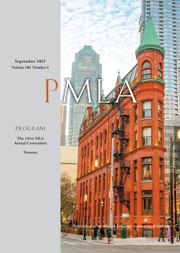No CrossRef data available.
Article contents
Reading Politically Red as Politically Black: On the Priority of Antiblackness and the Determination of the Crowd
Published online by Cambridge University Press: 01 September 2025
Abstract
An abstract is not available for this content so a preview has been provided. Please use the Get access link above for information on how to access this content.
Information
- Type
- Theories and Methodologies
- Information
- Copyright
- © 2025 The Author(s). Published by Cambridge University Press on behalf of Modern Language Association of America
References
Works Cited
Althusser, Louis. “From Capital to Marx’s Philosophy.” Reading Capital, by Althusser et al., translated by Ben Brewster, New Left Books, 1970, pp. 9–72.Google Scholar
Anderson, Kevin. Marx at the Margins: On Nationalism, Ethnicity, and Non-Western Societies. U of Chicago P, 2010.CrossRefGoogle Scholar
Arruzza, Cinzia. “Logic or History? The Political Stakes of Marxist-Feminist Theory.” Viewpoint Magazine, vol. 23, June 2015, viewpointmag.com/2015/06/23/logic-or-history-the-political-stakes-of-marxist-feminist-theory/.Google Scholar
Baraka, Amiri. “The ‘Blues Aesthetic’ and the ‘Black Aesthetic’: Aesthetics as the Continuing Political History of a Culture.” Black Music Research Journal, vol. 11, no. 2, 1991, pp. 101–09.CrossRefGoogle Scholar
Fanon, Frantz. Black Skin, White Masks. Translated by Charles Lam Markmann, Pluto, 1986.Google Scholar
Hegel, G. W. F. The Science of Logic. Translated by George di Giovanni, Cambridge UP, 2010.Google Scholar
Marx, Karl. Capital: A Critique of Political Economy. Vol. 1, translated by Fowkes, Ben, Penguin Books, 1976.Google Scholar
Marx, Karl. Grundrisse: Foundations of the Critique of Political Economy. Translated by Nicolaus, Martin, Penguin Books, 1973.Google Scholar
Moten, Fred. “Blackness and Nothingness (Mysticism in the Flesh).” The South Atlantic Quarterly, vol. 112, no. 4, 2013, pp. 737–80.CrossRefGoogle Scholar
Nesbitt, Nick. “Racial Capitalism and Social Form.” The Conformist Rebellion: Marxist Critiques of the Contemporary Left, edited by Lange, Elena Louisa and Pickett-Depaolis, Joshua, Rowman and Littlefield, 2022, pp. 175–99.CrossRefGoogle Scholar
Sexton, Jared. “Afro-Pessimism: The Unclear Word.” Rhizomes, vol. 29, 2016, www.rhizomes.net/issue29/sexton.html.Google Scholar
Sorentino, Sara-Maria. “The Abstract Slave: Anti-Blackness and Marx’s Method.” International Labor and Working-Class History, vol. 96, 2019, pp. 17–37.CrossRefGoogle Scholar
Sorentino, Sara-Maria. “With What Must Slavery Begin?” Differences, 3 Apr. 2024, differencesjournal.org/writing/with-what-must-slavery-begin.Google Scholar
Wilderson, Frank B. III. Red, White, and Black: Cinema and the Structure of U.S. Antagonisms. Duke UP, 2010.CrossRefGoogle Scholar

